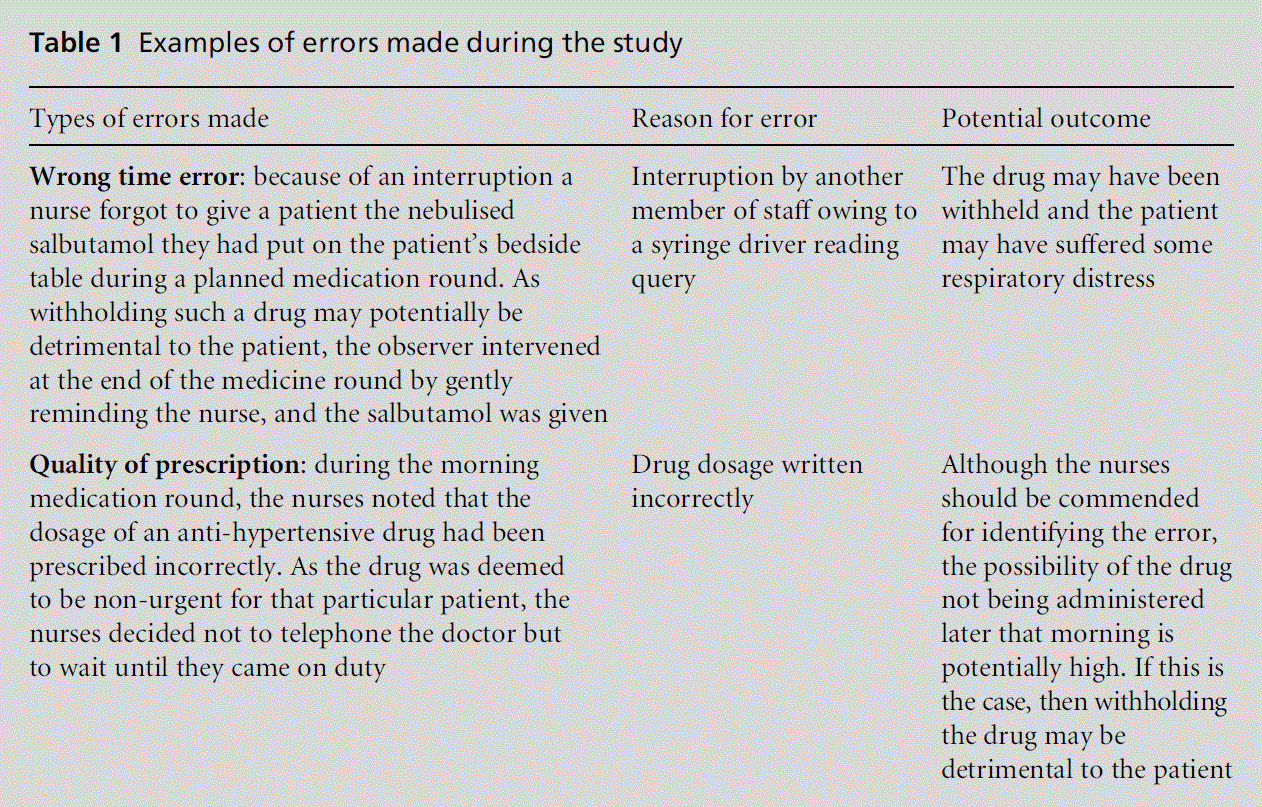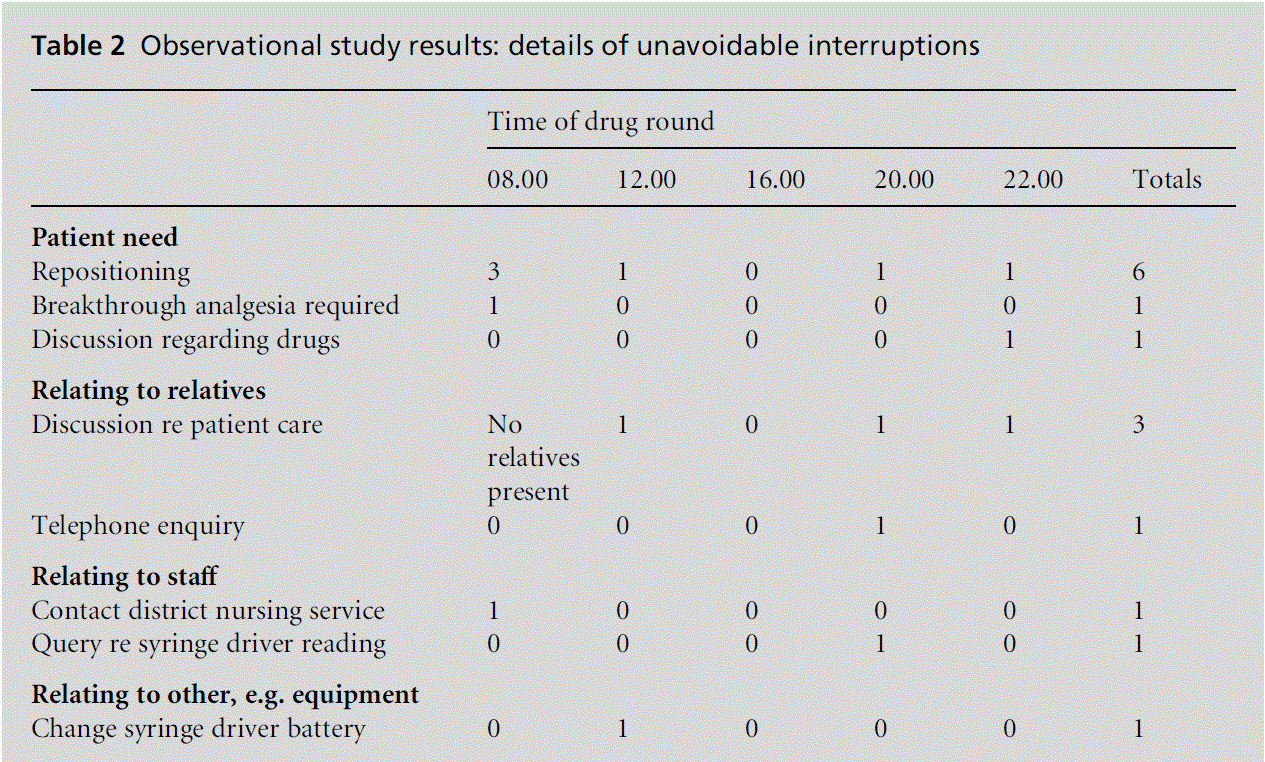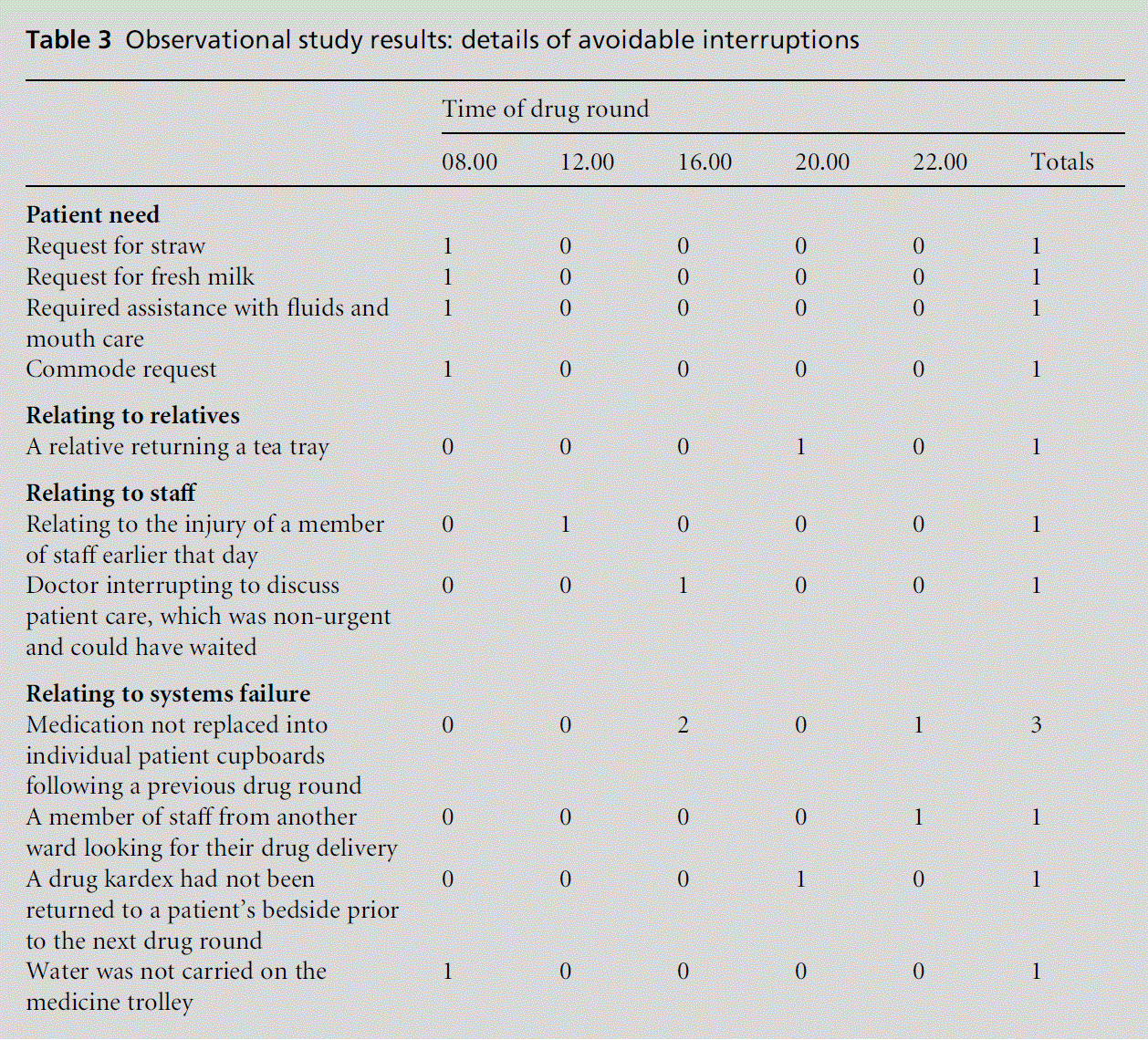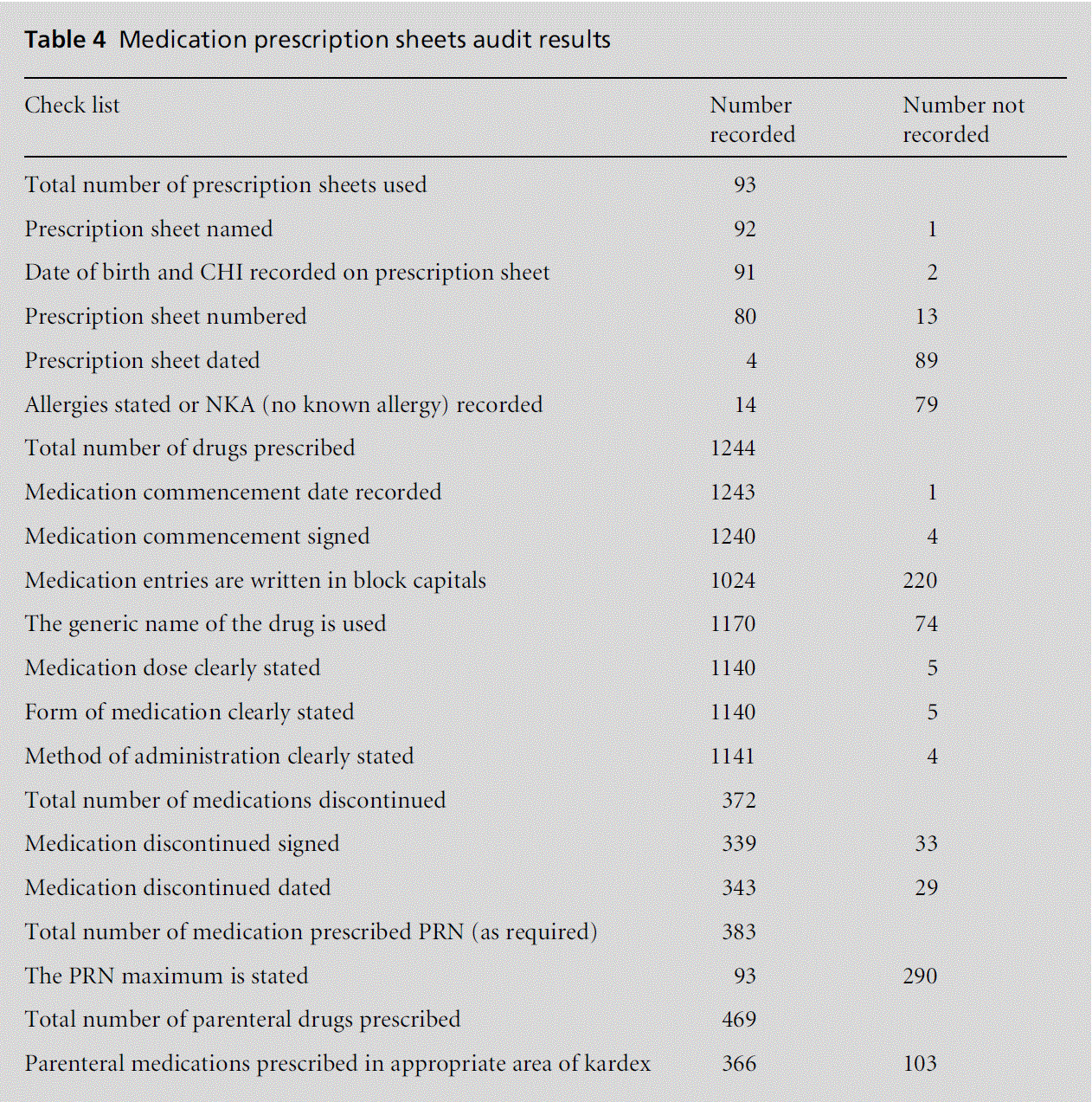Clinical Governance in Action - (2006) Volume 14, Issue 1
Clinical Co-ordinator
Gillian S Fenton RGN State Certified Midwife (SCM) BN*
Clinical Nurse Specialist – Clinical Governance
Dundee Community Health Partnership, Dundee, Scotland, UK
Received date: 5 August 2005; Accepted date: 25 August 2005
Aim To identify areas of practice that could be improved upon, thereby reducing the risk of medication errors and improving patient safety.Method An observational study of medication administration took place over five medication rounds, to collect data on interruptions and errors. A retrospective audit of medication documentation was conducted to collect data on the prescribing and recording of medication. The data collection took place over three afternoons and included all prescribing and recording sheets for 20 patients.Results During the observation study two errors were observed, one wrong time error and one quality of prescription error. Interruptions were classified as avoidable and unavoidable, and common themes identified. The medication documentationaudit exposed a number of serious issues such as allergies not being recorded on 79 (85%) prescription sheets and 103 (22%) parenteral medicines being prescribed in an inappropriate area of the prescription sheet. Conclusion The review has highlighted areas of practice, which, if improved upon, will not only reduce the risk of medication errors but also improve practice and patient safety.
audit, interruptions, medication errors, observation study, patient safety, systems review
Prescribed medication is the most frequent treatment provided to patients in the NHS.[1] The five rights of safe and effective medication management are clearly defined in law as: the right medicine is given to the right patient at the right time, in the right form of the drug and at the right dose.[2] All professionals who are involved in medicine management are governed by a legal and professional accountability to follow best practice when prescribing and administering medi-cation. This is essential in the provision of safe and effective patient care.[1] Drug administration is a multi-professional process, which involves the prescribing, writing, provision, preparation and administration of medication to the patient.
It has been shown that interruptions can contribute to administration errors.[1] It is also well-recognised that illegible or poor handwriting and improper use of abbreviations are major contributory factors towards error.[3,4]
There are four basic methods for detecting and counting errors in drug dispensing, prescribing and administration. These include, observation, self-reporting, testing and physical evidence, e.g. docu-ment review.[5] To expedite the development of strat-egies for reducing errors, it is necessary to identify where within the system the problems lie.
Observation as a technique has proved to produce valid and reliable results in identifying drug errors, distractions and interruptions and has many advan-tages over the other techniques.[5–8] Direct observation allows data to be collected with greater objectivity, thereby reducing the possibility of inferences being drawn.[8] It has the advantage of being easily under-stood and, importantly, it views errors in medication as errors in the system and does not assign blame.[5,9,10] It also gives clues to potential causes of the error without relying on the knowledge and memory of the person administering the medications.[5] It is, however, expensive and requires special training for observers.
Documentation review is less expensive and has proved to be useful in detecting medication prescrib-ing errors and poorly written prescriptions.[5,11]
This article describes a medication management system review, which was initiated to analyse, review and improve practice.
Background
The clinical area discussed in this review is an inpatient specialist unit where patients are admitted with complex needs, which commonly includes symp-tom management. The provision of effective symptom management can involve frequent changes in medi-cation as well as multiple prescriptions of both oral and parenteral drugs. The unit is a recognised clinical learning environment, and due to the specialist nature of care is a popular placement for medical, pharmacy and nursing students. These students rely on a set standard of clinical practice to ensure they become competent in all aspects of medication management.[12] Within the unit, local and national policies and pro-cedures are in place to reduce the risk of error. Staff are encouraged to report both actual and potential errors through the local incident reporting system.
The large number of drugs prescribed and the frequent changes in medication increase the risk of medication error.[13] The consequences of error can be devastating for both patient and professional. This was recognised and experienced by staff following an unprecedented number of medication errors. Five incidents had been reported over a two-week period, which was particularly unusual, as previously, on average, only one or two had been reported per year. The reason for this increase was unclear, although it was noted that each medication error had been caused by a chain of events involving various members of the multiprofessional team. In two separate incidents bottles of liquid medication had been dispensed from phar-macy with labels attached stating the name of the patient, the medications prescribed and dose to be administered. The labels were placed on the opposite side of the bottle to the manufacturer’s labels. The dose stated on the pharmacy dispensary label was inaccurate, but this was the only label read by the nurses administering the medication. As a result, on more than one occasion, the patients received a higher dose than prescribed. Fortunately this was detected within a short space of time and there were no adverse effects for either patient.
Three incidents related to illegible prescriptions, in one case the patient’s allergy status was mistaken due to the record being illegible. The patient received the medication but, fortunately, did not have a reaction. In the other two cases, the patient received the wrong dose of medication, again with no adverse effects. In all these incidents the patients involved were fully informed of the errors and reassured that a review of current practice would take place.
Staff morale was adversely affected by these events and, following a team discussion, it was agreed that a structured review would be helpful in identifying contributory factors.
It is essential that both staff and management learn from errors and this can only be achieved through systematic analysis and review.[14–16]
The analysis of the incidents included reflective discussions with staff where issues were raised regard-ing prescribing and administration practices. Staff discussed near-misses where inaccurate prescriptions and other potential errors, which could have adversely affected the patient, had been resolved but had not been reported. This troubleshooting and under-reporting of critical incidents is common practice among health-care professionals.[16,17] Historically, nurses were disci-plined for medication errors, but the adoption of the systems approach to risk management has moved the focus from the individual to analysing the processes
and procedures, thus identifying possible causal factors.[4,14,18]
The discussion highlighted several issues relating to illegible handwriting, inaccurate prescriptions and frequent interruptions, which required further analysis.
The local clinical governance team was approached for advice and guidance prior to undertaking the review, and a member of this team agreed to partici-pate and provide support. It was agreed to focus on the two main areas of practice highlighted in the initial discussions with staff. The review would therefore focus on medication documentation and medicine administration.
Aim
The aim of the study was to identify areas of practice that could be improved upon to reduce the risk of medication errors and increase patient safety.
Data collection methods
To ensure the review encapsulated not only the pre-scribing and recording of medicines but also the administration, it was agreed that more than one approach was required. Based on the reliability and validity of the observation technique and records review, a decision was made to adopt both approaches.
Observational study
Within the unit there are five main medication rounds within any given 24-hour period. The observation technique was used to collect data in order to deter-mine the level of interruptions experienced during drug administration, in addition to determining whether errors were being made as a result. The data collection took place over two days and involved five randomly selected medicine rounds. Prior to each of these medicine rounds, the nurses administering the medication were informed that an independent ob-server would be in attendance. The nature of the study was withheld from the other members of staff in an attempt to minimise any modification in their behav-iour. To ensure an objective, non-judgemental ap-proach was observed throughout, a member of staff from the clinical governance team, who had a nursing background, conducted the study.
The observer collected data on drug errors and any interruptions. The reason for and the length of the interruption were recorded as it was hoped that this information could be used to identify common themes. The observer’s opinion as to whether the interruption could have been avoided, although subjective, was believed to be a useful gauge of the urgency and necessity for the interruption. When it was evident that a nurse was about to commit an administration error that, in the observer’s opinion, would be detri-mental to the patient, it was agreed that the observer would intervene to avert the error.
The ratio of qualified to unqualified staff was recorded to identify if skill mix or the number of staff on duty had an impact on the number of interruptions. Vari-ations in the number of patients present in the ward were thought to be a contributory factor and therefore collection of this information was felt to be useful when analysing the data.
To ensure consistency, a data collection tool was developed and piloted prior to use.
Medication prescription and recording sheet audit
A retrospective audit was conducted to collect data on the prescribing, writing and recording of medicines. The data collection took place over three afternoons and included all prescribing and recording sheets for 20 patients who had been cared for within the unit over the past 6 months. The audit sample was ran-domly selected and included all medication documen-tation relating to the most recent episode of care.
The audit tool was developed using the standards set within the current local guidelines on medication management and was piloted several times by a pre-registration pharmacist not attached to the unit. A member of the clinical governance team reviewed the information collected after each pilot, and gave advice on amending the tool. A second pre-registration pharmacist who was independent of the unit, and was instructed in the use of the tool, undertook the data collection.
Data analysis
It is important to note that the analysis is purely descriptive.
Observational study
Two errors were observed, one related to medication being administered at the wrong time and the other related to the quality of the prescription, i.e. the pre-scription required to be amended (a full description of the errors observed is detailed in Table 1).

During the study period, the number of patients remained unchanged, but the length of time taken to complete each medicine round varied greatly, with the longest medicine round containing the greatest num-ber of interruptions (Figure 1).
Throughout the five medication administration rounds 62 minutes (35% of the total time) was spent dealing with interruptions. The greatest number of interruptions occurred at 08.00 when five staff were on duty, compared with the least number of interrup-tions occurring when only three staff were on duty. The observer used professional experience and clinical knowledge to determine whether the interruptions observed could be classified as avoidable or unavoid-able.
A total of 28 interruptions were recorded across the five medicine rounds, with 15 (54%) being classified as unavoidable and 13 (46%) being rated as avoidable (Tables 2 and 3).

The themes commonly identified as unavoidable interruptions related to direct patient care, commu-nicating with relatives and issues relating to staff, with the most common interruptions relating to repos-itioning the patient (Table 2).
Interruptions that were classed as avoidable had a variety of causes but the most common interruption related to medication not being replaced appropri-ately (Table 3).

Medication prescription and recording sheet audit
Within the 20 randomly selected patient notes, 1244 drugs were prescribed on 93 medicine prescription sheets and recorded on 39 medicine recording sheets.
The audit exposed a number of serious issues such as allergies not being recorded on 79 (85%) prescrip-tion sheets, 89 (96%) prescriptions sheets not being dated, and 103 (22%) parenteral medicines being prescribed in an inappropriate area of the prescription sheet. Where medication was prescribed on an ‘as required’ basis, the maximum number of doses was not stated in 290 (76%) entries (full audit results can be viewed in Table 4). Only 36 (92%) medicine recording sheets contained both date of birth and community health index (CHI).

Observational study
It is important to note that the two errors observed within the study are commonly cited as contributory factors in administration errors.[4,7,17]
Although 54% of interruptions were classed as unavoidable, the overall picture gives cause for con-cern. Interruptions are distracting and alter concen-tration, having the potential to increase the risk of administration errors.[3]
The number of interruptions did not appear to be related to the number or skill mix of staff on duty, as the number of registered staff available was consistent throughout the study.
It would appear having more staff available did not reduce the number of interruptions, but this does not take into consideration the variations in workload at different times of the day. For example, one of the unavoidable interruptions relating to repositioning patients occurred on three occasions at 08.00. Although there were five members of staff on duty, the other members of staff were serving the patients’ breakfast.
To reduce the number of interruptions, all staff need to be aware of the importance of deferring any non-urgent communications until the medication round has finished, and staff serving meals should ensure patients have all the resources they require for their meal.
There were also some practical issues identified which could be avoided by returning the drug kardex to the patient’s bedside, replacing empty packets/ bottles of current patient medicines at the end of each medicine round, and carrying a jug of water on the medicine trolley.
Medication prescription and recording sheet audit
The large number of medicines prescribed on the medicine prescription sheets and the number of changes in prescriptions for this patient group reflects the com-plex nature of symptom management. This reinforces the need for a high standard of documentation-related practice to reduce the risk of error. Clarity of hand-writing is a recognised factor in medication errors, and the results showed that practice could be improved. Patient identification details including name and date of birth are essential to ensure the right patient is given the right medicine. Although these details were miss-ing on only three kardex, this requires 100% com-pliance.
The patient’s allergy status must be recorded clearly to reduce the chances of the patient suffering a reaction to their medication.[19] The poor compliance noted in the results could have serious implications for prac-tice, and could have influenced the incident previously discussed.
For symptom management, many patients are frequently prescribed medicines such as analgesia or anti-emetics on an as-required basis, outwith normal prescription times. The maximum number of doses is commonly documented to ensure patients do not receive an overdose of a particular medication. From the results it can be seen that practice within the unit needs to improve.
Within the medicine prescription sheet there is a specific section where parenteral medication should be prescribed. In theory, prescriptions should be read thoroughly to identify the route of administration, but in practice nurses will automatically expect to see parenteral medication prescribed in this designated area of the documentation. In 22% of parenteral pre-scriptions, the medication was prescribed outwith this area of the medicine prescription sheet. This could increase the risk of parenteral medication being missed and not administered. There were areas of good prac-tice noted, for example the majority of prescriptions were dated and signed and the dose, form and route clearly stated.
Within the unit, due to the complex medication regimes and the frequency of administering controlled medication, it has been agreed, as good practice, that two nurses would administer all medication. The find-ings showed that on occasions only one nurse signed the entry. The recording sheet data collection tool failed to record the number of entries that were signed, therefore the proportion of times this occurred could not be measured. Within the recording sheet there is a small space to record why patients refused their medication. Comments were, in the majority of cases, not recorded, which can affect patient care when medication is being reviewed, and there may be un-certainty as to why medication has not been given.
The results of the review were compiled into a report, which was distributed to nursing, medical and clinical pharmacy staff within the unit. Within the report, recommendations included improving record keeping and deferring interruptions. Following a meeting with key personnel, an action plan was agreed. This involved staff education and the devel-opment of an information sheet, which reinforced areas of practice that required to be improved. Of the many factors involved in interruptions during medi-cation administration, some could easily be remedied through communicating to staff the importance of not interrupting nurses during this procedure. Deferring interruptions from relatives has been more difficult to resolve, especially in light of the nature of the clinical work, and discussions regarding this are ongoing. Staff have been encouraged to continue reporting both actual and potential incidents, as this will allow on-going monitoring and evaluation of the medication system.[14]
Limitations of the study
It is recognised that the review is single sited and therefore the results are unable to be generalised.
Although the observation technique is a valid and reliable method of detecting errors, distractions and interruptions, it is financially and logistically imposs-ible for the observer to be present 24 hours a day, 7 days per week.[5–8] As a result, the study has probably only identified some of the errors made and interruptions experienced while conducting medication adminis-tration.
Another criticism of this data collection method is that the observer may affect the process that is being observed.[7] Although it was difficult to judge the full effect of the observer in this study, it was felt that their presence had minimal effect on the staff who were unaware of the nature of the study.
The data-recording tool did not record how many entries were signed on the medication-recording sheet. Therefore the proportion of times this occurred could not be measured. This made it difficult to put the findings into context.
All professionals who are involved in medicine man-agement are governed by a legal and professional accountability to follow best practice when prescrib-ing and administering medication. It was the aim of this study to highlight areas of practice that could be improved, thus reducing the risk of error. The review has shown that there are many areas of medication management, which, if acted upon, will increase patient safety. This includes improving multiprofessional record keeping, and deferring interruptions during medi-cation administration. A future review is planned to ensure the recommendations have been implemented and practice has improved. Taking a proactive multi-professional approach to reducing the risk of medi-cation errors will positively impact on patient safety.
None.